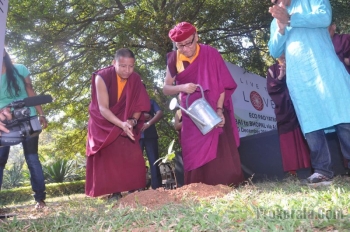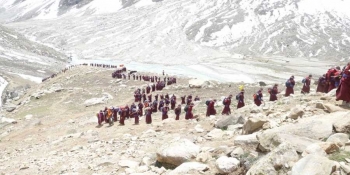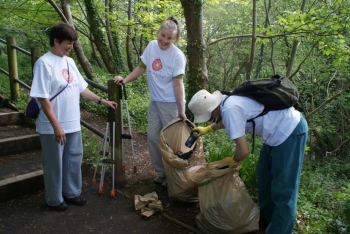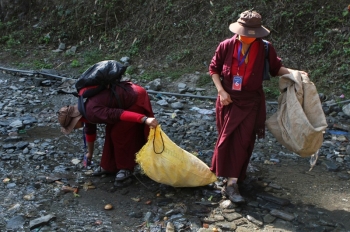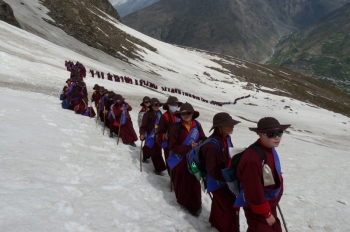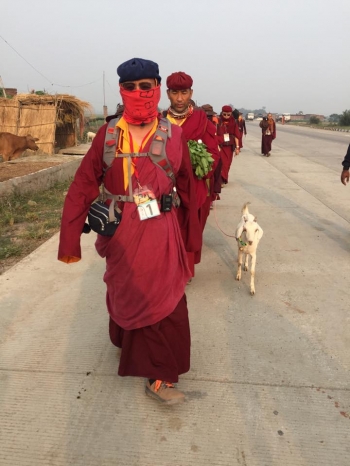“A Pad Yatra is not only a physical journey, but also an inner journey of transformation.” - Pad Yatra website
An age-old tradition that is similar to a pilgrimage, the Pad Yatra is said to have originated in the Himalayas. Embarking on a Pad Yatra is much more than simply undertaking a journey on foot; it is challenging both physically and mentally, and requires true team effort to complete.
The tradition has been transformed into at least an annual event by His Holiness the Gyalwang Drukpa, who masterminded the gathering of resources and announced the first contemporary Pad Yatra in 2009. Crossing five Himalayan passes and taking roughly 42 days, a group of 400 nuns and 200 monks walked for about 249 miles through the mountains of Ladakh, visiting the holy sites of Chakrasamvara, Avalokiteshvara, Guru Padmasambhava, and the siddha Naropa en route.
The Gyalwang Drukpa’s pilgrimages are not only for spiritual benefit, however, but also play an important role in nature conservation. The Pad Yatra has now developed into an environmentally friendly expedition, the “Eco Pad Yatra,” and for this and various other endeavors His Holiness has been named a United Nations Millennium Development Goal Honoree. Participants are not only mindful of their surroundings, but also educate villagers on climate change, biodegradable and non-biodegradable materials, and sustainability along the way. The Gyalwang Drukpa’s enthusiasm for the green movement is quoted on the website drukpa-nuns.org: “We all have a great responsibility to take care of the Himalayas for all sentient beings,” he says. “This is one of the main reasons that we organized this Eco Pad Yatra. We need to appreciate Mother Earth and keep it green and clean.”
The website reports that during the 2009 Pad Yatra, participants collected an astonishing 60,000 plastic bottles, 10,000 chewing gum and tobacco wrappers, and 5,000 empty cans—and these staggering numbers were recorded after they had completed just a third of the route. Gathering these items from streams, ravines, and the trekking path, it quickly became clear that the yatra was to assume a new and profound responsibility.
The same thing occurred during the Sikkim Pad Yatra in 2010. Here, His Holiness was accompanied by several other Rinpoches, including Drukpa Yongdzin Rinpoche and Gyalwa Lorepa, along with 400 nuns, monks, and laypeople. The 2010 trek involved prayers, pujas, visits to sites blessed by Guru Padmasambhava, and meditation, as well as cleaning up the surrounding areas. A Drukpa Kagyu lineage nun recounts their journey: “Walking, sometimes 10 hours a day, still left time for practices and fire pujas to be conducted outside, sometimes in temperatures of minus 15 degrees. Hot mugs of tea were always gratefully received to revive fingers numbed from playing damaru (small drums) and bell.”
The 7th Eco Pad Yatra is currently under way, and will run until 30 November. Some of the holy sites to be visited are Varanasi, Bodh Gaya, Nalanda, and Vulture Peak. The yatra is open to anyone, and can be joined midway. The pilgrimage will encompass fighting environmental degradation in India and Nepal, all the while maintaining the traditional aspects of a pad yatra. Participants can also collect donations for various causes. The Los Angeles Times describes the Eco Pad Yatra as a “Call to save the Planet.”
The 7th Eco Pad Yatra is currently under way, and will run until 30 November. Some of the holy sites to be visited are Varanasi, Bodh Gaya, Nalanda, and Vulture Peak. The yatra is open to anyone, and can be joined midway. The pilgrimage will encompass fighting environmental degradation in India and Nepal, all the while maintaining the traditional aspects of a pad yatra. Participants can also collect donations for various causes. The Los Angeles Times describes the Eco Pad Yatra as a “Call to save the Planet.”
Taking the scenic pilgrimage onto a cinematic platform, in 2012 producer and director Wendy J. N. Lee joined the Himalayan yatra and recorded it in a visually stunning documentary titled Pad Yatra: A Green Odyssey. “Surviving harrowing injuries, illness, and starvation, they emerge with nearly half a ton of plastic litter strapped to their backs, triggering an historic green revolution across the rooftop of the world,” reads the synopsis. The yatra was joined by some 700 people. In an interview with Ada Tseng (asiapacificarts.usc.edu), Lee describes the incredible journey: “I didn’t realize how difficult it’d be, how much physical strength would be needed, or how much you learn about yourself when you're exhausted,” she says. “Over time, you’re almost happier when you're exhausted, because you don’t have the energy to be angry or complain, so you just go with the flow. I ended up really enjoying myself. Up until that point, I don’t think I had been happier in my life.”
